<Click on chart for larger image>
- Bloomberg Business – Forget Interest Rates, the Fed Has Another Big Decision to Make in the Next Year
In case exiting years of zero interest rates won’t be hard enough, Federal Reserve officials have another challenge approaching quickly: when to begin unwinding trillions of dollars of bond purchases that constitute the world’s largest fixed-income portfolio. Less than a year from now, the Fed must decide whether to reinvest $216 billion of proceeds from Treasury debt maturing in 2016, or shrink its balance sheet by allowing it to expire. By not reinvesting, the Fed would increase the supply of securities available to investors and put upward pressure on yields. Shrinking the $4.2 trillion portfolio will add to the monetary tightening from increases in the benchmark interest rate officials envision for this year. That would mark a reversal of the easing the Fed achieved when it bought bonds to speed a recovery from the worst recession since the 1930s. The timing will be tricky. Fed Chair Janet Yellen, concerned the economy remains fragile, has said the pace of rate increases is likely to be gradual and cautious. A decision to start unwinding the Fed’s bond portfolio could give her more reason to proceed slowly or even stop raising rates for a time, said Drew Matus, deputy U.S. chief economist at UBS Securities LLC in New York. “From an economist’s perspective, you kind of want one thing happening at a time,” said Matus, a former analyst on the New York Fed’s open-market desk. “Our baseline view is that they keep the pace of rate hikes slow as they are moving toward and into the initial roll-off period, but it’s also possible that becomes a great time for them to pause for six months.”
Comment
One popular version of the Taylor Rule was published in June 2011 by the San Francisco Federal Reserve:
The Taylor rule is a policy guideline that generates recommendations for a monetary authority’s interest rate response to the paths of inflation and economic activity (Taylor 1993). According to one version of this rule, policy interest rates should respond to deviations of inflation from its target and unemployment from its natural rate (Rudebusch 2010). A simple version of this rule is:
Target rate = 1 + (1.5 x Inflation) – (1 x Unemployment Gap)
The target rate recommended by the rule is a function of the inflation rate and the unemployment gap. That gap is defined as the difference between the measured unemployment rate and the natural rate, that is, the unemployment rate that would cause inflation neither to decelerate nor accelerate. The literature shows that this simple rule or close variations approximate fairly well the policy performance of several major central banks in recent years (see Taylor 1993 and Peersman and Smets 1999).
The Federal Reserve’s preferred measure of inflation is the headline year-over-year (YoY) change in PCE. Using this measure, their preferred target is 2.0% (as of January 2012).
Although the natural unemployment rate is currently a highly debated topic, the OECD states it is currently 5.45%. Dennis Lockhart recently estimated it was around 5% or possibly lower.
Here is the raw data used in the Taylor Rule:
Latest YoY PCE is 0.33%
Latest YoY core PCE is 1.37%
February’s unemployment rate (to match the February PCE data) was 5.50%
From which we get the following inputs:
PCE Inflation = 1.5 X 0.3% = 0.45%
Core PCE Inflation = 1.5 X 1.37% = 2.055%
Unemployment gap = 5.50% – 5.45% = 0.05%
We can apply these inputs to the San Francisco Federal Reserve’s Taylor Rule equation and get the following results for February 2015 (latest data):
Using YoY PCE:
Target = 1% + 0.45% (PCE inflation) – 0.05% (unemployment gap) = +1.40%
Using YoY Core PCE:
Target = 1% + 2.055% (Core PCE inflation) – 0.05% (unemployment gap) = +3.005%
Below are charts of the Taylor Rule’s implied funds rate (red line,top panel), the actual funds rate (blue line, top panel) and the difference between the two (green line, bottom panel). The top chart uses headline PCE and the bottom chart uses core PCE.
<Click on chart for larger image>
<Click on chart for larger image>
Although many different iterations of the Taylor Rule exist, the results above are consistent with most other Taylor Rule estimates in targeting a positive funds rate. Despite this, the FOMC has thus far been reluctant to hike rates.
How Much Does “Additional Accommodation” Lower The Funds Rate?
Regarding how much unconventional policy (i.e., QE) matters, Bernanke offered the following testimony in February 2011:
MR. BERNANKE: We tried to make an assessment of — we asked the hypothetical question: If we could lower the federal funds rate, how much would we lower it? And a powerful monetary policy action in normal times would be about a 75-basis-point cut in the federal funds rate. We estimate that the impact on the whole structure of interest rates from 600 billion (dollars) is roughly equivalent to a 75-basis- point cut. So on that criterion, it seemed that that was about enough to be a significant boost, but not one that was excessive.
In October 2010 Bill Dudley answered a very similar line of questioning in much the same way. He stated that $500 billion of purchases would provide as much stimulus as a 50 to 75 basis point cut in the funds rate.
Bernanke and Dudley were talking about excess reserves held by banks at the Federal Reserve when they quoted these figures. As the following charts show, excess reserves now stand near $2.6 trillion.
<Click on chart for larger image>
<Click on chart for larger image>
Using the logic above, each $6.66 billion to $10 billion of excess reserves lowers the “accommodative fed funds rate” by one basis point. With excess reserves at roughly $2.4 trillion as of the end of February, the actual funds rate has been lowered by 240 bps to 360 bps to the accommodative fed funds rate shown in the charts below.
So, with an actual funds rate at roughly 0.25% for the foreseeable future, additional excess reserves put the “accommodative fed funds rate” between -2.15% and -3.35%, which has a mid-point of -2.75% (the mid-point of the accommodative funds rate is plotted below).
<Click on chart for larger image>
<Click on chart for larger image>
Conclusion
Because rate hikes appear to be the next step towards normalizing policy, the markets have correctly focused on timing the first move. However, the effect of the Fed’s bloated balance sheet should not be overlooked. Based on the math shown above using a variety of inputs, the federal funds rate is too low, especially when excess reserves (QE) are factored in.

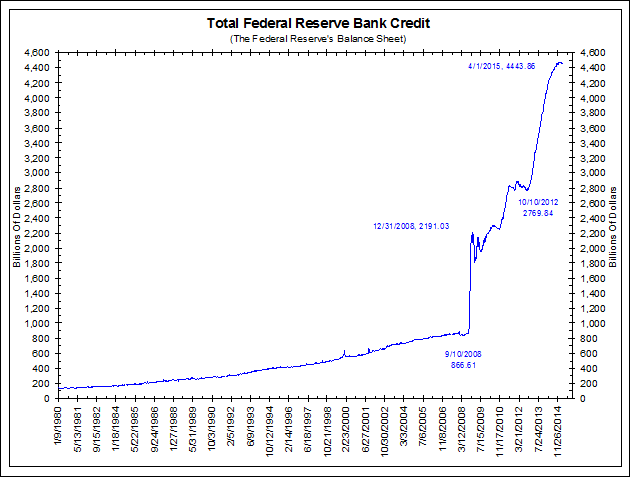
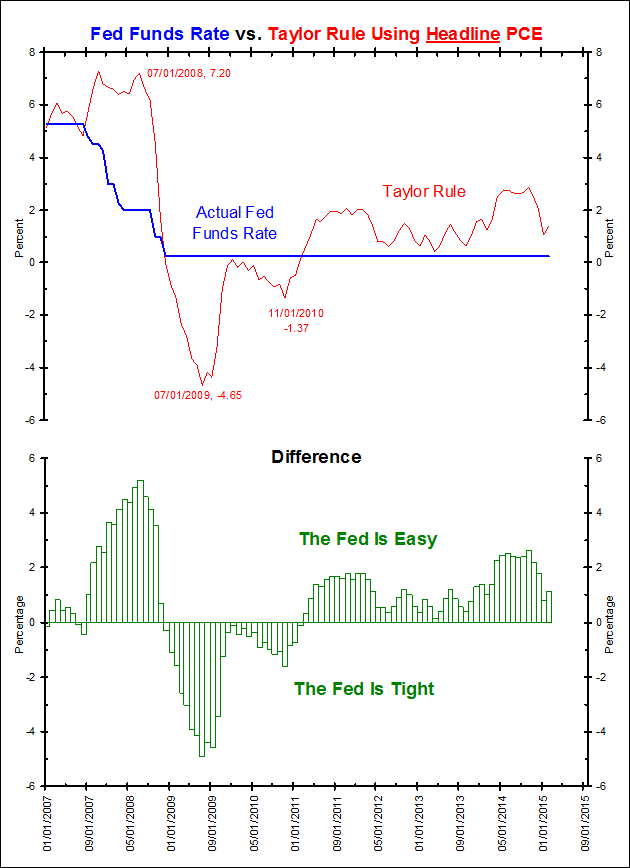
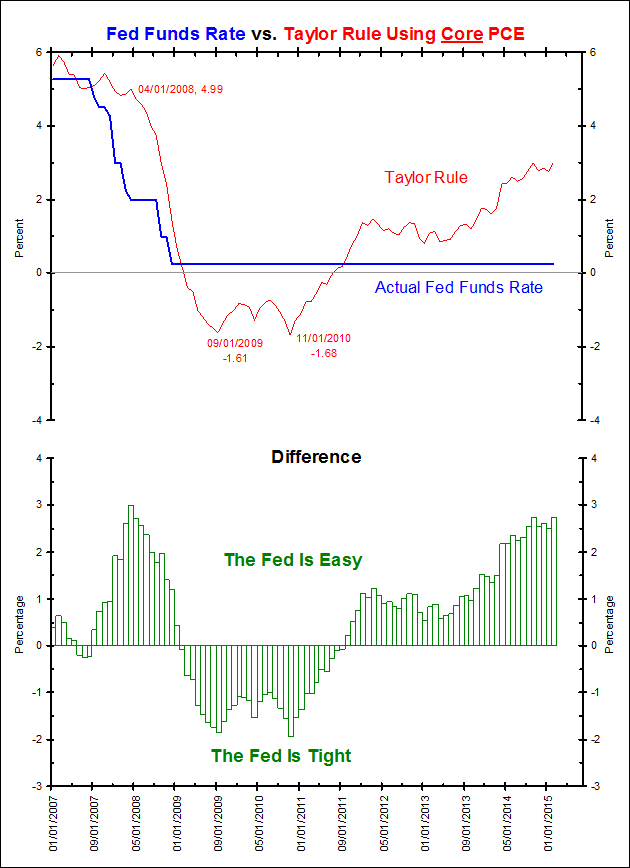
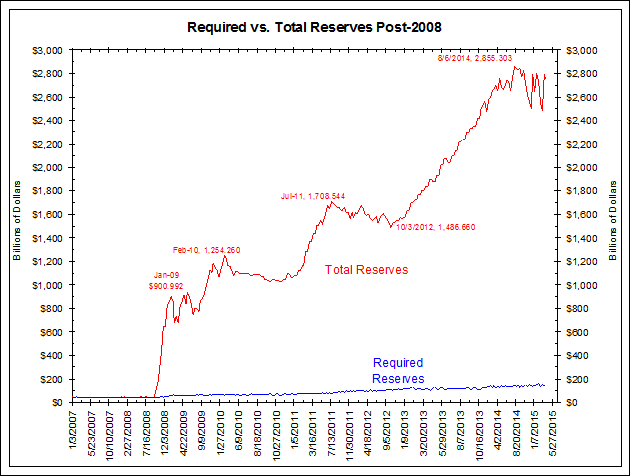
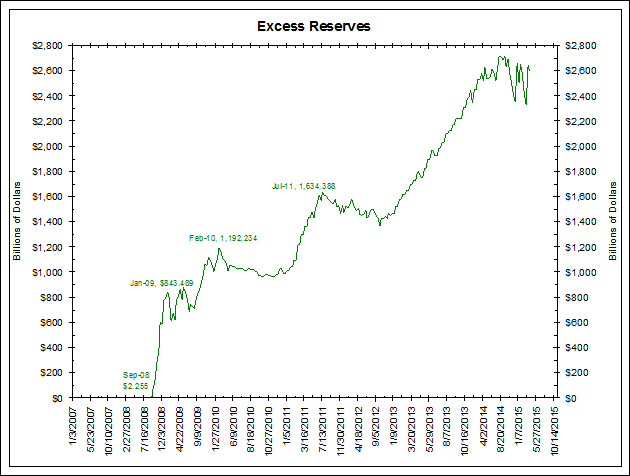
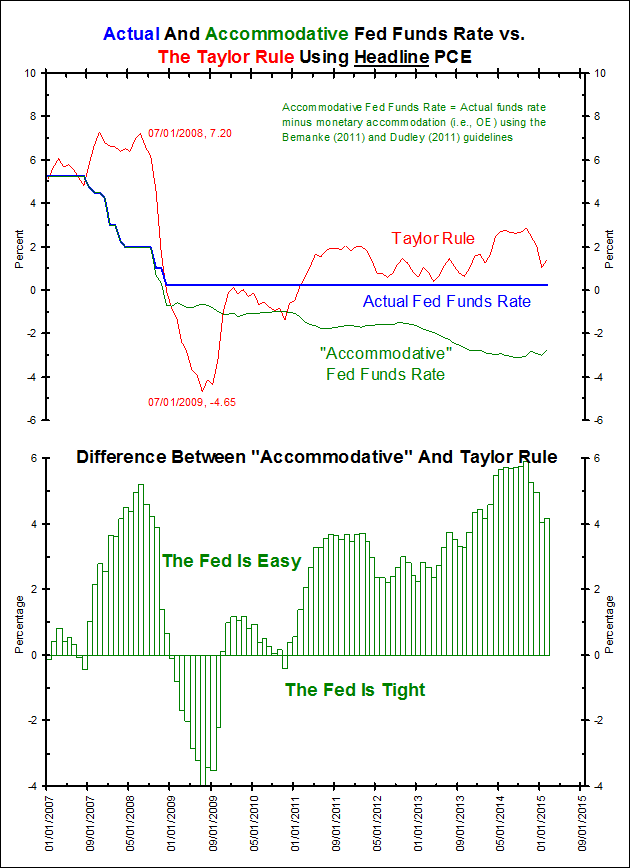
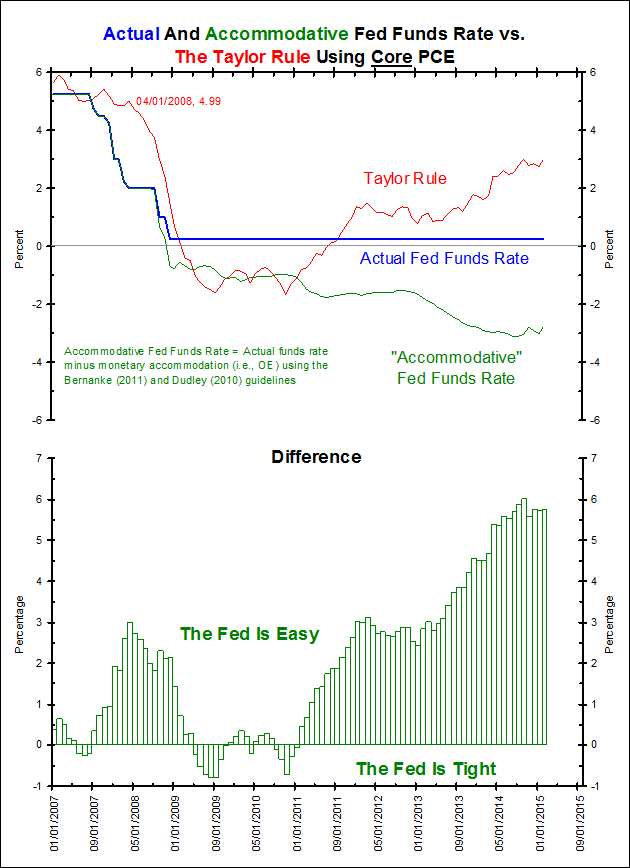
As the markets debate the timing of the first rate hike, it is important to keep in mind rates are actually still well below zero because of the various injections via QE over the past several years. As the story above points out, the Fed still has to make some major decisions on how or when they will shrink their balance sheet.
Based on comments made by FOMC officials since QE’s inception, it is possible to estimate just how far below zero rates actually are. First, a quick look at the Taylor Rule shows us where the neutral funds rate is currently.